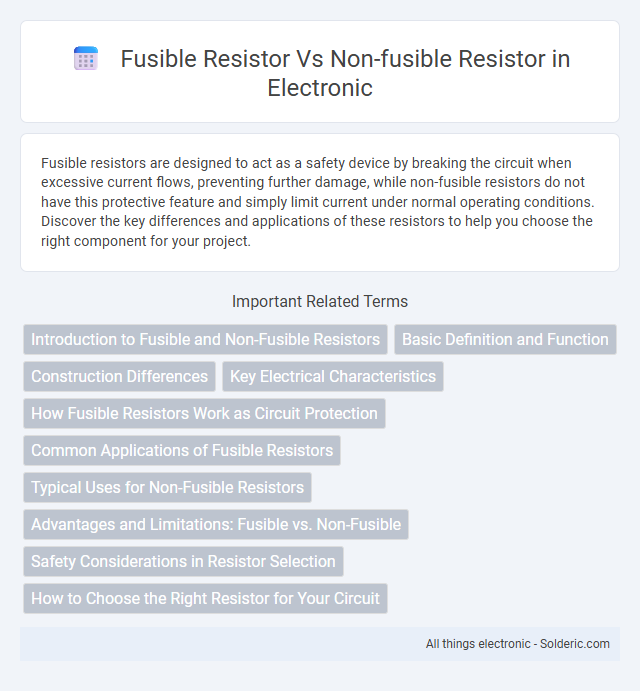Fusible resistors are designed to act as a safety device by breaking the circuit when excessive current flows, preventing further damage, while non-fusible resistors do not have this protective feature and simply limit current under normal operating conditions. Discover the key differences and applications of these resistors to help you choose the right component for your project.
Comparison Table
| Feature | Fusible Resistor | Non-Fusible Resistor |
|---|---|---|
| Function | Acts as a resistor and fuse; interrupts circuit on overload | Only limits current; does not provide circuit protection |
| Safety | Provides automatic circuit interruption during fault | No self-protection; risk of damage or fire on failure |
| Application | Used in power supplies and protection circuits | Used in general-purpose circuits without fuse requirements |
| Construction | Designed to open circuit when overloaded | Stable resistor element without fuse function |
| Cost | Generally higher due to added safety feature | Lower cost, standard resistor use |
| Failure Mode | Fails open to protect circuit | Fails resistive or short, possible damage |
Introduction to Fusible and Non-Fusible Resistors
Fusible resistors are designed to act as both a resistor and a fuse, protecting circuits by breaking the circuit path when excessive current flows, thereby preventing damage. Non-fusible resistors simply limit current without the built-in protective feature to interrupt the circuit during fault conditions. Understanding the difference helps you select the right resistor to ensure circuit safety and reliability in your electronic designs.
Basic Definition and Function
A fusible resistor combines the properties of a resistor and a fuse, designed to open the circuit when overloaded to protect other components. Non-fusible resistors simply limit current flow without providing overcurrent protection and remain intact under fault conditions. Understanding the basic function helps you select the right resistor for safety-critical applications.
Construction Differences
Fusible resistors feature a special construction with a resistive element designed to melt and disconnect the circuit when excessive current passes through, providing built-in overcurrent protection. Non-fusible resistors use a stable resistive element that maintains electrical continuity under fault conditions, focusing solely on resistance without the ability to interrupt current flow. The key construction difference lies in the fusible resistor's integrated fuse function, achieved by materials and layering engineered for rapid thermal response and controlled failure.
Key Electrical Characteristics
Fusible resistors combine the resistance function with a built-in fuse, designed to open the circuit when excessive current causes overheating, offering protection against short circuits or overcurrent conditions. Non-fusible resistors provide stable resistance without self-protection, suitable for applications where circuit interruption is managed by other devices. Understanding your circuit's safety requirements helps determine whether the key electrical characteristic of self-fusing or consistent resistance is more critical for your component choice.
How Fusible Resistors Work as Circuit Protection
Fusible resistors combine the functions of a resistor and a fuse, offering circuit protection by melting and breaking the circuit when excessive current flows, preventing damage to other components. Their construction includes a resistive element designed to open the circuit under abnormal conditions, unlike non-fusible resistors which only limit current without providing fail-safe disconnection. Commonly used in power supplies and electronic devices, fusible resistors enhance safety by interrupting fault currents and reducing fire hazards.
Common Applications of Fusible Resistors
Fusible resistors are commonly used in power supplies, consumer electronics, and industrial equipment to provide overcurrent protection by combining resistance with a built-in fuse function. These components help prevent damage to circuits by interrupting excessive current flow, making them ideal for safety-critical applications such as power adapters and switching power supplies. Your electronic designs benefit from enhanced reliability and protection when incorporating fusible resistors in these high-risk environments.
Typical Uses for Non-Fusible Resistors
Non-fusible resistors are typically used in applications requiring stable resistance under normal operating conditions without the need to protect against overcurrent by fuse action. Common uses include precise signal conditioning, voltage division, and feedback circuits in electronic devices where safety is managed by other means. Your choice of non-fusible resistors ensures reliable performance in sensitive circuits where interruption from resistor failure would be detrimental.
Advantages and Limitations: Fusible vs. Non-Fusible
Fusible resistors provide the advantage of acting as a safety device by melting and breaking the circuit when excessive current flows, preventing further damage to electronic components, whereas non-fusible resistors primarily offer stable resistance without built-in protection. Fusible resistors have limitations such as limited power ratings and potential reliability issues under repeated fault conditions, while non-fusible resistors are more suitable for applications requiring consistent resistance and better tolerance to thermal stress. The choice between fusible and non-fusible resistors depends on whether circuit protection or precision resistance is the primary requirement.
Safety Considerations in Resistor Selection
Fusible resistors are designed to protect circuits by acting as a fuse that cuts off current during overloads, enhancing safety in applications prone to short circuits or excessive current. Non-fusible resistors lack this self-protective feature and primarily serve to limit current or divide voltage without interrupting the circuit during faults, making them less suitable for high-risk safety requirements. Selecting fusible resistors in critical circuits minimizes fire hazards and equipment damage by ensuring timely disconnection under fault conditions.
How to Choose the Right Resistor for Your Circuit
Choosing the right resistor for your circuit depends on safety requirements and failure containment. Fusible resistors act as a fuse by breaking the circuit during overloads or short circuits, preventing further damage and enhancing protection in critical applications. Non-fusible resistors provide stable resistance without interruption but may require additional protective components to safeguard the circuit under fault conditions.
fusible resistor vs non-fusible resistor Infographic

 solderic.com
solderic.com